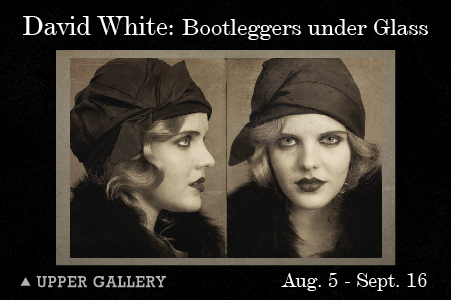David White – “Bootleggers Under Glass”
August 5 – September 16, 2018

David White moved to Hoboken when it was thick with vestiges of its gritty, mid-20th century “On the Waterfront” period. He moved here after college in 1983, already an accomplished street photographer, having grown up in Manhattan with a love of the medium. He had honed his skills on assignments in high school and at Ohio University, and began working as an apprentice to professional photographers in Manhattan.
When he landed in Hoboken, he fell in love with the city’s old factory buildings and historic vibe. He loved prowling through the streets, shooting the graffiti-covered Levelor and Maxwell House factories and the crumbling waterfront. He married and raised a family here, while building a successful commercial studio business, shooting celebrities and models for major corporate and magazine clients from his 5,000-square-foot studio near Union Square in Manhattan.
Although his work concentrates on creating perfect images for commercial clients, White has always been drawn to artistic capabilities of photography, having been raised by two artists,
a commercial illustrator for a father and an art director and sculptor mother, who met while plying their skills for Bloomingdales.
An opportunity to shoot a campaign for a liquor company named Prohibition Distillery in 2016 sparked his creative imagination. At a tasting for the company’s Bootlegger 21 Vodka at the W Hotel in Hoboken, he pitched one of the company’s principals, Brian Facquet, on a campaign to recreate the glass-plate process look of vintage mugshots from the 1920s using modern digital technology. The result is a series now on display in the Hoboken Museum’s Upper Gallery, “Bootleggers Under Glass,” on view through September 16.
“Under glass” is one of many 1920s-era euphemisms for being in jail, says White. He was fascinated by the look of wet plate collodion process of photography from the time, with the unintended imperfections that come from the laborious process. The technique meant that the photographer coated glass plates with chemicals, loaded them in a camera for the shot and processed it in a dark room right away. It didn’t give the subjects — whether for portraiture or police file photos — many chances at striking the perfect pose. The result was a realistic portrayal of the subject’s state of mind. It also resulted in an almost painterly feel and texture, with imperfections that couldn’t be digitally erased back in the day.
White, who now works almost exclusively with digital equipment, enjoyed the challenge of adding these imperfections, tonal qualities and textures to mimic the look of authentic 1920s mugshots. He also had to coax his models for the Bootleggers series into the right frame of mind to portray hard-bitten booze smugglers caught by the law. Having a case of the Bootlegger 21 vodka on hand helped, he says. Several of his subjects are avid fans of the Jazz Age, and brought their own vintage clothes and accessories to the photo shoot.
“The project was the perfect marriage of commercial and personal work,” White says. “Each image probably represents two days’ worth of work on the computer to achieve the desired effect — longer than the actual wet plate process in a dark room, but without the dangerous chemicals.”
White has enjoyed a few exhibits of his work over the years, with this series having been part of a Jazz Age-themed exhibit at Raoul’s French restaurant in New York. Hobokenites might have seen his work on display over the years in some of the local coffee shops frequented by the artists here, including Mola, Frozen Monkey, Park Pastries, and others. He still enjoys spending time with his fellow Hoboken artists at Bwé café.
